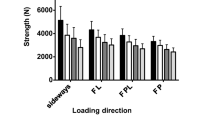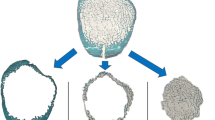Abstract
Bone mineral density (BMD) is a predictor of fracture risk. The purpose of this study was to determine whether a correlation exists between femoral neck BMD and an indicator of mechanical bone strength in human and bovine samples. Human proximal femurs were obtained from seven men and two women undergoing total hip arthroplasty (THA), mean age 60.3 years. Preoperative BMD measurements of the femoral neck were obtained (Lunar DPX). A 3 cm2 area of interest on each excised femoral neck corresponding to the preoperative BMD measurement site was carefully marked and BMD was remeasured postoperatively. Ten excised bovine femoral necks were also measured for BMD. A bicortical core, each cortex 2.8 cm2 in area, containing the center of the area of interest was removed from the human and bovine femoral necks, cut into multiple 7-mm thick, multiple cross-sectional discs, and measured for hardness by indent depth (Rockwell International Hardness Tester, Wilson Mechanical Instruments, New York, NY). In vivo human femoral neck BMD measurements correlated with in vitro BMD measurements (r=0.99). BMD measurements of human femoral necks were significantly lower than BMD measurements of bovine femoral necks (P<0.05). Inverse relationships were found between in vivo and in vitro human BMD measurments and indent depth (r=-0.58 and -0.59, respectively). Bovine BMD measurements and indent depth were also inversely related (r=-0.64). When combined, the in vitro human and bovine samples showed an increased correlation between indent depth and BMD (r=-0.77). In conclusion, in vivo and in vitro BMD measurements of the femoral neck are virtually identical. BMD values correlate inversely with indent depth in both human and bovine femoral samples. The data indicate that indent depth is a measurement that assesses biomechanical properties of bone which are reflected in BMD measurements.
Similar content being viewed by others
References
Melton LJ III, Eddy DM, Johnston CC (1990) Screening for osteoporosis. Ann Intern Med 112:516–528
Prince RL, Smith M, Dick IM, Price RI, Webb PG, Henderson NK, Harris MM (1991) Prevention of postmenopausal osteoporosis. N Engl J Med 325:1189–1195
Hui SL, Slemenda CW, Johnston CC (1989) Baseline measurement of bone mass predicts fracture in white women. Ann Intern Med 111: 355–361
Johnston CC Jr, Slemenda CW, Melton LJ III (1991) Clinical use of bone densitometry. N. Engl J Med 324:1105–1109
Overgaard K, Hansen MA, Riis BJ, Christiansen C (1992) Discriminatory ability of bone mass measurements (SPA and DEXA) for fractures in elderly postmenopausal women. Calcif Tissue Int 50:30–35
Wasnich RD, Ross PD, Heilbrun LK, Vogel JM (1985) Prediction of postmenopausal fracture risk with use of bone mineral measurements. Am J Obstet Gynecol 153:745–751
Faulkner KG, Cummings SR, Black D, Palermo L, Gluer CC, Genant HK (1993) Simple measurement of femoral geometry predicts hip fracture: the study of osteoporotic fractures. J Bone Miner Res 8:1211–1217
Riggs BL, Melton LJ III (1986) Involutional osteoporosis. N Engl J Med 314:1676–1686
Black DM, Cummings SR, Melton LJ III (1992) Appendicular bone mineral and a woman's lifetime risk of hip fracture. J Bone Miner Res 7:639–646
Carter DR, Hayes WC (1977) The compressive behavior of bone as a two-phase porous structure. J Bone Joint Surg [Am] 59-A: 954–962
Black DM, Cummings SR, Genant HK, Nevitt MC, Palermo L, Browner W (1992) Axial and appendicular bone density predict fractures in older women. J Bone Miner Res 7:633–638
Harris S, Dawson-Hughes B (1992) Rates of change in bone mineral density of the spine, heel, femoral neck and radius in healthy postmenopausal women. Bone Miner 17:87–95
NIH consensus conference paper on osteoporosis (1984) JAMA 252:799–802
Hui SL, Slemenda LW, Johnston CC Jr (1988) Age and bone mass as predictors of fracture in a prospective study. J Clin Invest 81:1804–1809
Hui SL, Slemenda W, Johnston CC, Appledorn CR (1987) Effects of age and menopause on vertebral bone density. Bone Miner 2:141–146
Schaadt O, Bohr H (1988) Different trends of age-related diminution of bone mineral content in the lumbar spine, femoral neck, and femoral shaft in women. Calcif Tissue Int 42:71–76
Standard test methods for Rockwell hardness and Rockwell superficial hardness of metallic materials (1989) ASTM Standards—Specifications E 18-89a, pp 176–189
Evans FG, Lebow M (1951) Regional differences in some of the physical properties of the human femur. J Appl Physiol 3:563–572
Doppler RA (1993) Bone mechanical property determination through superficial Rockwell hardness testing. MS Thesis. Worcester Polytechnic Institute, Worcester, MA.
Faulkner KG, Gluer CC, Majumdar S, Lang P, Engelke K, Genant HK (1991) Noninvasive measurements of bone mass, structure, and strength: current methods and experimental techniques. Am J Radiol 157:1229–1237
Dalen N, Hellstrom LG, Jacobson B (1976) Bone mineral content and mechanical strength of the femoral neck. Acta Orthop Scand 47:503–508
Beck TJ, Ruff CB, Warden KE, Scott WW, Rao GU (1990) Predicting femoral neck strength from bone mineral data: a structural approach. Invest Radiol 25:6–18
Author information
Authors and Affiliations
Rights and permissions
About this article
Cite this article
Houde, J., Marchetti, M., Duquette, J. et al. Correlation of bone mineral density and femoral neck hardness in bovine and human samples. Calcif Tissue Int 57, 201–205 (1995). https://doi.org/10.1007/BF00310259
Received:
Accepted:
Issue Date:
DOI: https://doi.org/10.1007/BF00310259




